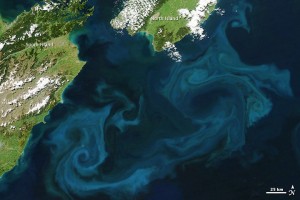http://earthobservatory.nasa.gov/NaturalHazards/view.php?id=40924&src=nha
Satellite photo of a spring phytoplankton bloom just east of New Zealand, where there is a convergence of warm and cold currents. If you go to the link you can see a much more detailed image over a larger area.
Melissa


Hello All.
Went to the website recommended by Melissa and was pleased to confirm that the lovely colours were created by goodies! Fishing in that area should be rewarding.
Peter
—-
Some New Age types and some mathematicians might think that there are fractals at work here.
See http://en.wikipedia.org/wiki/Fractal especially the pics about half way down.
Or, see http://en.wikipedia.org/wiki/Fractal
George:
While the New Age types might say there are "fractals at work" they’d be seriously wrong. The fractals don’t do anything. They’re just a mathematical way of describing some natural processes where form seems to be independent of size scale, not a cause of anything. But you knew that. However, I have nothing against fractals, and they appear in one of my poems:
Melissa
At 11:26 AM 10/28/2009, you wrote: